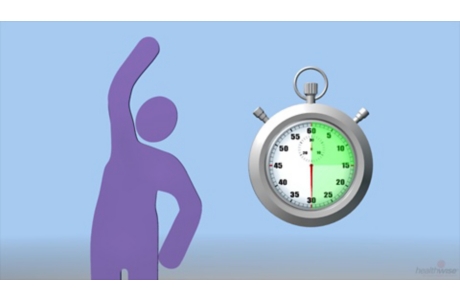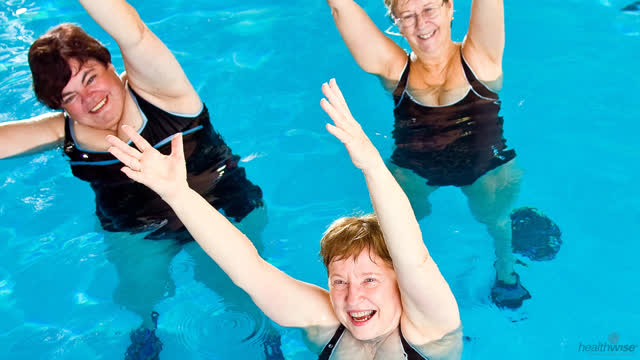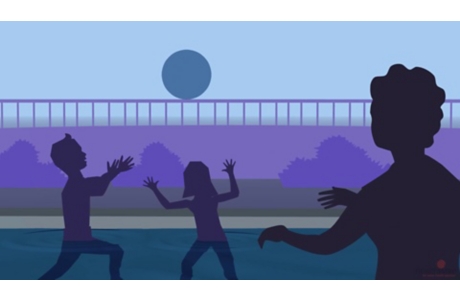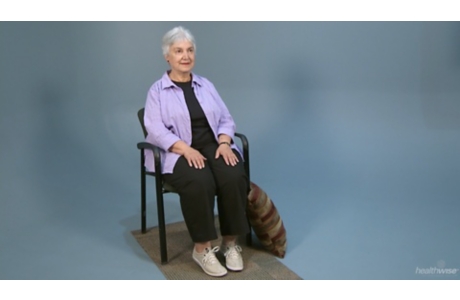Fitness: Getting and Staying Active
Overview
What is "being active"?
Being physically active means doing any kind of activity that gets your body moving. There are different kinds of physical activity. Aerobic activities strengthen your heart and lungs and build up your endurance. Strength training activities help tone and strengthen your muscles and bones. Stretching helps you be more flexible.
What are the benefits of being active?
Being active is one of the best things you can do to get fit and stay healthy. It helps you feel stronger and have more energy. It can help you lose fat, build muscle, and reach a healthy weight. Being active may also help you feel better, sleep better, and focus.
How much physical activity can help you get fit and stay healthy?
How often you do aerobic exercise depends on how much time you have, how hard you exercise, and how long you exercise. It also depends on your overall goals.
Aerobic exercise includes walking, running, cycling, swimming, and dancing.
Experts recommend that adults try to do moderate activity for at least 2½ hours a week. Or they can do vigorous activity for at least 1¼ hours a week. You can choose to do one or both types of activity. And it's fine to be active in shorter periods of time throughout the day and week that add up to the recommended goals.
How long each exercise session lasts depends on how hard you exercise. If you exercise at an intense rate, you probably won't exercise as long. You can gradually increase how long you exercise as your endurance increases.
Choose an activity that you enjoy. This will help you stay with your program and meet your goals.
Strength training
Experts say it's best to do exercises to strengthen bones and muscles at least 2 times each week.footnote 1 For example, you could do weight training or stair climbing.
How can you make it easier to get active?
Small changes can make it easier to get active. To start, focus on your reasons—your motivation. Then find things you enjoy doing, like outdoor activities or exercising with a friend. Pick a goal, like walking more, and think of small steps that help you reach your goal. Reward yourself for your success.
Health Tools
Health Tools help you make wise health decisions or take action to improve your health.
Why Should You Be More Active?
Being active is one of the best things you can do for your health. It helps you to:
- Feel stronger and have more energy to do all the things you like to do.
- Focus better at school or work.
- Feel, think, and sleep better.
- Reach and stay at a healthy weight.
- Lose fat and build lean muscle.
- Lower your risk for serious health problems, including diabetes, heart attack, high blood pressure, and some cancers.
- Keep your heart, lungs, bones, muscles, and joints strong and healthy.
Benefits of being active when you have a health problem
When you are living with health problems, regular exercise and activity are important. They keep you healthier, give you energy, make you stronger, and help your mood.
Exercise and activity can help many health problems. When you're active, you are less likely to have problems caused by diabetes, heart disease, lung disease, and arthritis. And being active can help protect you from new health problems.
Regular exercise:
- Helps control stress, depression, and anxiety.
- Helps manage blood pressure and cholesterol.
- Lowers your risk for heart attack and stroke.
- Makes your lungs stronger.
- Can help you reach a healthy weight.
- Keeps your blood sugar at a healthy level.
- Can build bone strength.
Learn more
Watch
What Does "Being Active" Really Mean?
Being physically active means doing any kind of activity that gets your body moving.
The types of physical activity that can help you get fit and stay healthy include:
- Aerobic or "cardio" activities. These make your heart beat faster and make you breathe harder, such as brisk walking, riding a bike, or running. They strengthen your heart and lungs and build up your endurance.
- Strength training activities. These make your muscles work against, or "resist," something. Examples include lifting weights or doing push-ups. These activities help tone and strengthen your muscles and bones.
- Stretches. These let you move your joints and muscles through their full range of motion. Stretching helps you be more flexible.
Reaching a balance between these three types of physical activity is important because each one contributes to your overall fitness.
Aerobic exercise
Aerobic exercises increase the amount of oxygen that is delivered to your muscles. More oxygen helps the muscles work longer. This helps you do more activities for longer periods of time.
Any exercise that raises your heart rate and keeps it up for a long time will improve your aerobic fitness. These exercises include:
- Walking.
- Using a treadmill.
- Cycling or using a stationary bicycle.
- Swimming.
- Water aerobics.
Daily activities can also be aerobic. These activities include:
- Walking to work or to run errands.
- Sweeping (perhaps to fast-paced music).
- Playing actively with children.
- Walking your dog.
Talk to your doctor before starting a new exercise program. Your doctor will help you know how often and how long to exercise. You can also get help setting your long-term exercise goals.
Strength-building exercises
Building stronger muscles is an important part of overall health. You can do exercises to strengthen muscles at least 2 times a week. Be sure to work the major muscle groups: legs, hips, back, belly, chest, shoulders, and arms.
- Do resistance training.
Strength training helps build muscles through regular use, especially when your muscles have to work against something. When a person exercises against resistance, the muscles are stressed slightly but not to the point of serious damage or injury.
Examples of resistance-training exercises include:
- Basic muscle-conditioning exercises, such as push-ups, leg lifts, sit-ups, squats, and lunges.
- Working with rubber tubing or stretchable bands.
- Weight training with free weights (dumbbells) or weight-training equipment.
- Do exercises to strengthen your core.
This helps build the muscles around your belly and back (trunk). This is called core stability. It can help you have better posture and balance and help protect you from injury.
Stretching for flexibility
Flexibility means being able to move your joints and muscles through their full range of motion. As you become more flexible, you will find it easier to reach things on high shelves, look under a bed, or even tie your shoes. You will also have a better sense of balance and coordination.
It's best to warm your muscles a bit before you stretch them. Walk or do some other light aerobic activity for a few minutes, and then start stretching.
- Stretch all your major groups of muscles.
These include the muscles of your arms, your back, your hips, the front and back of your thighs, and your calves.
When you stretch your muscles:
- Do it slowly. Stretching is not about going fast or making sudden movements.
- Don't push or bounce during a stretch.
- Hold each stretch for at least 15 to 30 seconds, if you can. You should feel a stretch in the muscle, but not pain.
- Breathe out as you do the stretch. Then breathe in as you hold the stretch. Don't hold your breath.
- Start slowly, and increase your efforts bit by bit.
You can measure your progress with flexibility by noticing how much farther you can do each stretch. Can you stretch farther each day than you could when you started? If so, your flexibility is getting better.
Learn more
Watch
How Can You Become More Active?
Being more active doesn't have to be about "starting a program" or "exercising." What matters is finding an activity that appeals to you and makes you feel good.
Some ways to get started include:
- Finding your motivation.
Think about why you want to be active. Maybe you'd like to have more energy or relieve stress. Having your own reasons for being more active can fuel your motivation and get you moving.
- Choosing activities you enjoy.
Maybe you like exercising outdoors or taking a workout class with a friend. If you get bored, mix it up. Try something new.
- Taking small steps.
Pick a goal to focus on, and break it down into smaller, doable steps. For example, you could start doing 10-minute walks after lunch, then work up to a bigger goal over time.
- Rewarding yourself.
This is the best part. How will you celebrate your success?
Ways to be more active
There are many ways you can be more active. Anything that makes you breathe hard and gets your heart pumping is exercise. Climbing stairs instead of taking an elevator, mowing your lawn, or even cleaning can all be exercise. You may also want to walk, take exercise classes, or join a health club.
If you're ready to add more physical activity to your life, here are some tips to get you started.
- Talk to your doctor before you start.
If you have any health problems, or if you have not exercised in many years, talk to your doctor about:
- What activities are safe for you.
- How hard and how often you should exercise.
- What your goals should be. These may change as you get into better shape.
- Start slowly.
Start with simple activities, such as biking, slow swimming, or chores that get you breathing harder. Walking is a great fitness activity that most people can start doing. Increase your activity day by day.
- Make physical activity a regular part of your day.
Make a habit of using stairs, not elevators, and walking to do errands near your home. Take a daily walk with family members, friends, coworkers, or pets.
- Choose an activity you enjoy.
Find an activity that you enjoy, and stay with it. Vary it with other activities so you don't get bored. Whatever activities you choose, the key is to make exercise a habit that becomes a regular part of your life.
- Find an activity partner.
If you have problems exercising regularly on your own, ask someone to exercise with you. Or join an exercise group or health club. This can make exercising more fun.
Learn more
- Change a Habit by Setting Goals
- Exercise and Physical Activity Ideas
- Exercise Planning Form
- Fitness: Adding More Activity to Your Life
- Fitness: Choosing Activities That Are Right for You
- Quick Tips: Getting Active as a Family
- Quick Tips: Getting Active at Home
- Quick Tips: Getting in Shape Without Spending Money
Hear from others
Watch
How Can You Stay Active?
If you've started a program to get more active but are having trouble keeping it going, it may help to figure out what's getting in your way. Then you can decide how to get back on track.
Illness, travel, work, and just having a bad day are a few of the things that may keep you from staying on track. Your goal is to get back in the habit and find a way to make physical activity a routine part of your life.
Here's how to make being active a habit.
- Remember your reasons for being active.
For example:
- Are you exercising to stay healthy?
- Do you like how exercise makes you feel?
- Do you enjoy being active as a way to spend time with family and friends?
- Do you think being more active will help you with your weight goals?
- Update your goals.
When you first started increasing your activity, you probably had one or more big goals in mind.
- Are those goals the same today, or do you need to change them? Are you having trouble meeting those goals? You may need to come up with new long-term or short-term goals.
- Did you take on too much too fast? Remember to make your short-term goals small steps. For example, if you want to build up to walking 30 minutes every day, start by walking just 10 minutes a day on a few days each week. After a week, add 1 or 2 minutes every day, or add another day to your schedule.
- Did you meet your long-term goal and then stop? Good for you for meeting your goal! Now it's time to set a new long-term goal to help you stay active. Even people who have been active for years set new goals to help themselves stay motivated.
- Get past your slip-ups and anything that's getting in your way.
When you slip up, don't get mad at yourself or feel guilty. Figure out what happened. Then come up with some ways to get back on track. For example:
- If you feel that you don't have time to exercise, maybe you could talk with other people who are active and busy about how they fit in physical activity.
- If weather gets in your way, you might try a variety of indoor activities.
- If you're bored with your routine, you could watch a movie while you exercise at home. Listen to a podcast while you go for a walk or a run. Take a dance or yoga class.
- Get support.
Support from family and friends can go a long way toward helping you find success in being more active. Don't be afraid to let them know what you're trying to do—and ask for their help.
- Keep at it.
Remember that you can't create a habit overnight. Keep at it, even if you slip up along the way. It can take at least 3 months of repetition to form a habit. So every day that you follow your plan to be more active, you take a step in the right direction.
Learn more
- Fitness: Getting Around Barriers to Exercise
- Fitness: Staying Active When You Have Young Children
- Fitness: Teaching Your Child to Stay Active
- Quick Tips: Fitting Physical Activity Into Your Day
- Quick Tips: Having Enough Energy to Stay Active
- Quick Tips: Staying Active When You Travel
- Support for Staying Active
Can You Be Physically Active As You Get Older?
It's never too late to start getting active. Being fit is important for everyone. You can benefit from physical activity even if you already have conditions such as arthritis or heart disease. Being more active will help you feel better. And it may even help you live longer.
If you haven't been active for a long time, you may have no idea where to start. The important thing is to take that first step—and make that first step a small one.
- Talk with your doctor if you're worried about how exercise might affect your health.
If you're already active, ask your doctor if there is anything you should change to stay safe as your body and health change.
- Start slow.
If you have been inactive for years, start with about 5 to 10 minutes of activity at a time. Then increase your time as you get more comfortable with the activity.
- Try to improve only a little bit at a time.
Pick one area for improvement first. Set your personal goal in that area. Meet that goal before you try another area.
- Don't overdo it!
Some minor soreness or stiffness is to be expected at first. But pain is a warning sign to stop.
Learn more
Watch
How Can You Prevent Injury and Illness?
You've decided to start being active. That's great. No matter what activities you choose, the key is to make exercise a habit that becomes a regular part of your life. Here are some tips to help you start being active and do it safely.
- Check with your doctor before you start.
Moderate physical activity is safe for most people. But it's always a good idea to talk to your doctor before you start any new activity, especially if you haven't been very active or you have health problems. Talk to your doctor about:
- What activities are safe for you.
- How hard and how often you should exercise.
- What your goals should be. These may change as you get into better shape.
- Start slowly.
Increase your activity day by day. Start at a pace that is comfortable for you. It's fine to be active in short periods of time such as 10 or 15 minutes throughout your day and week.
- Don't overtire yourself.
Start with simple activities, such as walking, riding a bike, slow swimming, or chores that get you breathing harder.
- Be sure to warm up and cool down.
Warm up your muscles for a few minutes before you start to exercise. And cool down your muscles for a few minutes when you finish. You can walk, slowly move your arms and legs, or do simple muscle stretches.
- Drink plenty of water.
Be sure to drink plenty of water before, during, and after you are active. This is very important when it's hot out and when you do intense exercise.
- Find a fitness buddy.
If you have problems exercising regularly on your own, ask someone to exercise with you. Or join an exercise group or health club.
- Know when to stop.
If you have pain or severe breathing problems while you exercise, stop exercising. Call your doctor right away.
Learn more
Watch
Credits
Current as of: June 5, 2023
Author: Healthwise Staff
Clinical Review Board
All Healthwise education is reviewed by a team that includes physicians, nurses, advanced practitioners, registered dieticians, and other healthcare professionals.
Current as of: June 5, 2023
Author: Healthwise Staff
Clinical Review Board
All Healthwise education is reviewed by a team that includes physicians, nurses, advanced practitioners, registered dieticians, and other healthcare professionals.
This information does not replace the advice of a doctor. Healthwise, Incorporated, disclaims any warranty or liability for your use of this information. Your use of this information means that you agree to the Terms of Use. Learn how we develop our content.












